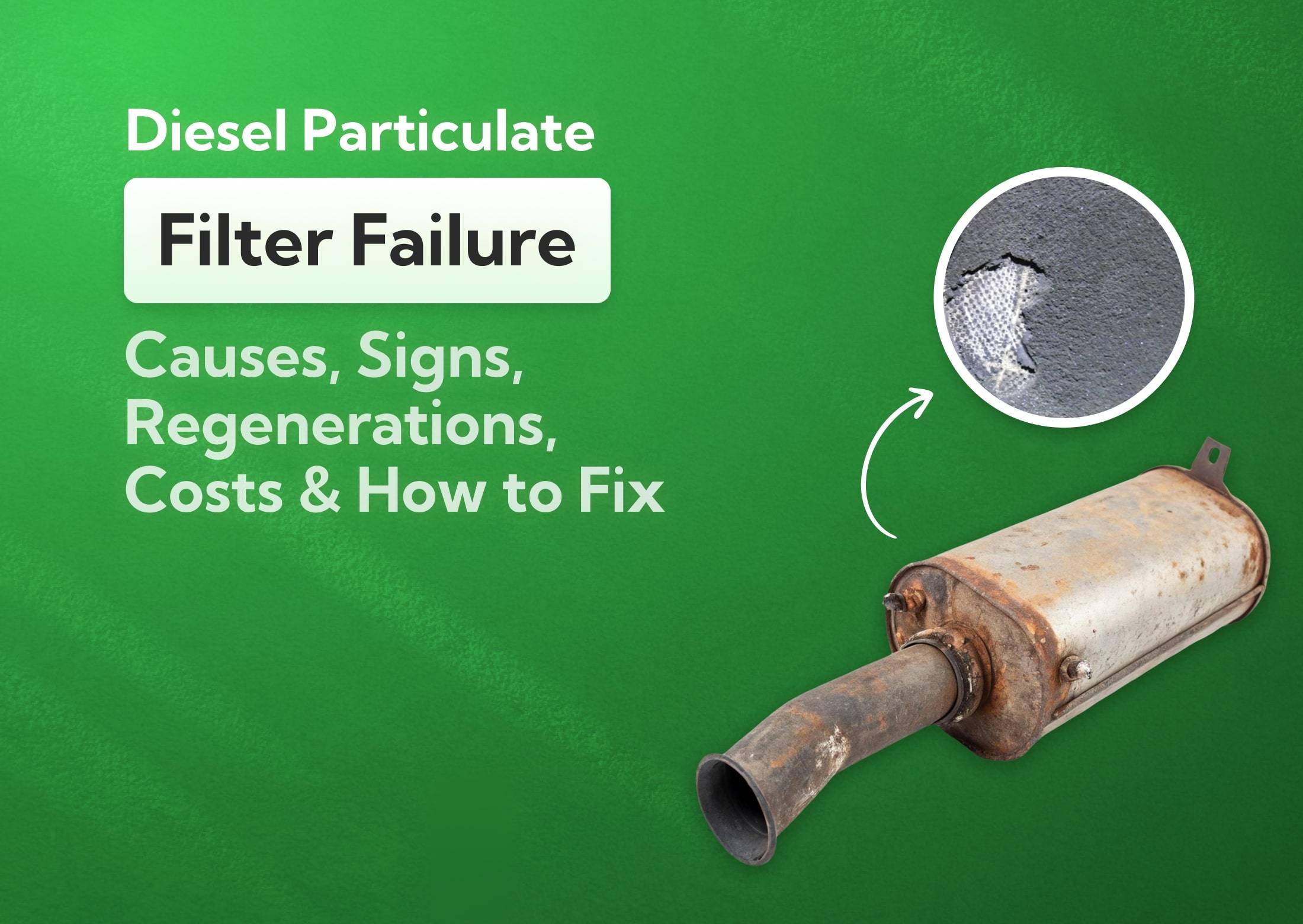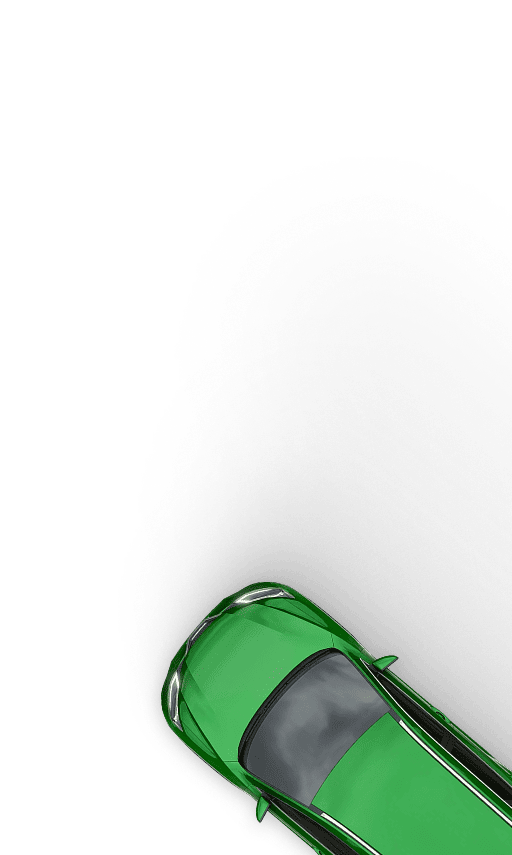Diesel Particulate Filter Failure: Causes, Signs, Regenerations, Costs and How to Fix
A failing DPF will turn a perfectly good diesel into a sluggish and expensive headache if you don’t fix it ASAP. This guide gives you the clear signs to watch for, what causes blockages, how much repairs really cost, when cleaning or replacing the filter are feasible options and when you should scrap it instead.
Last updated: 27th November, 2025

Anthony Sharkey is COO at New Reg Limited (Car.co.uk, Trader.co.uk, Garage.co.uk), driving innovation in vehicle recycling, logistics, and customer experience.

Listen to this story
A clogged or failing DPF sneaks up on a lot of drivers. One week the car feels fine, the next it’s sluggish and flashing a warning light you’d rather pretend isn’t there. Modern diesels rely on the DPF to trap soot, but once it stops regenerating properly, the whole system starts misbehaving.
In fact, soot overload is what causes most DPF failures, and that mainly comes down to maintenance and how often you take short trips vs longer ones (since the exhaust has to be hot enough to burn anything off). It might also be faulty sensors interrupting the regen cycle.
Either way, ignoring it will snowball into four-figure repairs because DPFs are expensive to replace. So if you’re having DPF or emissions issues, it’s a good thing you’re here.
In today’s guide, I’ll walk you through everything you need to know about DPF failure: early symptoms, common causes, your repair options and when it’s better to scrap your car.
What's in this article
What is a diesel particulate filter (DPF)?
A diesel particulate filter (DPF) is a ceramic filter in your exhaust system designed to trap the soot your engine produces. Instead of letting those tiny particles blow straight out of the tailpipe, the DPF catches and stores them so your car meets UK emissions standards.
As you drive, the filter periodically heats up and burns that soot into ash through a process called regeneration. When everything’s working properly, you never notice it happening. The exhaust gets hot enough, the soot burns away and the DPF stays clear.
This matters because a diesel engine builds up soot every single time it runs. If the DPF can’t burn it off, the filter slowly clogs. Once that happens, performance drops, fuel use climbs, warning lights appear and the engine starts protecting itself by reducing power.
In other words: a healthy DPF keeps your diesel running clean. A failing one throws the entire system off balance and tanks your emissions.
What are the causes of DPF failure?
Most DPF failures happen because the filter can’t regenerate often enough to burn off the soot it’s collecting. It’s simpler than you think – the reasons usually come down to driving habits, engine issues or faulty components in the regeneration system. If you’re using the wrong kind of oil or a low-quality fuel, that could cause it as well.
Here’s a closer look at each of those problems:
- Short trips and low-speed driving: Your DPF needs sustained heat to regenerate. Frequent short runs or stop-start driving never let the exhaust reach the temperatures required to burn soot, so it simply piles up until the filter blocks.
- Low-quality fuel: Cheap or contaminated diesel burns less cleanly, producing more soot than the DPF can realistically handle. Over time, that extra buildup causes it to clog faster and shortens the filter’s lifespan.
- Engine misfires and combustion issues: When your car’s engine isn’t burning fuel properly because it’s misfiring or the internal combustion engine isn’t working, it sends unburnt fuel and excess soot straight into the DPF. That overloads the filter and might stop regeneration from working altogether.
- Faulty sensors: The DPF relies on temperature, pressure and oxygen sensors to know when to regenerate. If any of them fail or send incorrect readings, the car won’t trigger regeneration at the correct time, which in turn causes rapid soot buildup and DPF failure.
- Oil dilution: If diesel seeps into the engine oil from incomplete regenerations caused by the issues above, the thicker, contaminated oil produces more soot when it’s burned. That extra soot heads straight into the DPF. Thicker oil also doesn’t lubricate your engine as well, which causes engine overheating, which further damages the DPF.
What are the signs of DPF failure?
If your diesel particulate filter is on its way out, you’ll usually feel it before you see it. The car starts losing power, the throttle feels heavy, fuel economy drops and the engine just seems… off.
Then the warnings kick in. A DPF light (maybe a check-engine light on older cars) and possibly even limp mode if there’s a serious underlying issue. You might also notice the cooling fans running more often, a bit of smoke when you drive the car under load or a harsher exhaust note because the system’s struggling to push gases through a clogged filter.
What matters is that you recognise and respond to the following signs early to prevent further damage:
- DPF warning light on dashboard: This is the car’s way of saying the filter is getting too full and starting to fail. It’s the earliest and most reliable clue that regeneration isn’t happening like it’s supposed to.
- Loss of engine power and sluggish acceleration: A clogged DPF restricts exhaust flow and the engine has to work harder to push gases through it. You feel that as slow acceleration and a general lack of pull.
- Increased fuel consumption: When the DPF is having a hard time, combustion suffers and the engine burns fuel less efficiently as a result. You end up burning more diesel just to get the same performance while driving around town.
- Black smoke from the exhaust: If the problem’s moved past initial stages, excess soot slips through and builds pressure in the system. That’s why when the DPF is overwhelmed or damaged, you see visible black plumes of smoke while driving.
- Difficulty starting the engine: A severely blocked DPF creates exhaust system backpressure, which throws off the engine’s ability to start cleanly. Cold starts, in particular, become noticeably harder when this happens.
The last sign signals the most critical issue with DPF failure. When the exhaust system creates too much excess backpressure, it could damage the EGR valve, turbocharger (if you have one) or potentially the engine itself. Worst-case scenario, you’re looking at total engine failure.
What do I do if my DPF warning light comes on?
If your DPF light comes on, there’s no need for you to panic. That said, don’t ignore it either because like just I mentioned, DPF failure will, at some point, lead to significant engine damage.
There are four steps to take, which I’ll walk you through below:
- Check engine condition. First things first, does the car drive more or less normally, or does it feel flat and unwilling to rev? Any strange noises, warning smells or clouds of smoke? If you’ve got other warning lights on (engine management, glow plug, temperature) or it feels rough or unsafe, don’t push it. That’s a “get it checked by a mechanic” situation.
- Try regenerating the DPF. You can usually clear a full DPF by giving the car the conditions it needs to regenerate. Warm the engine first, then hold a steady run at higher speeds for 20 to 30 minutes with the revs around 2,000 to 2,500 to trigger passive or active regeneration. Active regen happens when the car adds a small extra fuel injection to heat the exhaust; passive regen simply relies on exhaust temps naturally reaching 300ºC to 400°C. If your car supports it, check the infotainment menu or dashboard prompts – some models let you start a regeneration cycle manually when the DPF is nearing capacity.
- Consider driving at high speeds for a while. If your car doesn’t give a clear “regen in progress” message, a simple real-world approach is a decent run at dual carriageway or motorway speeds. Aim for 20 to 30 minutes of continuous driving, again keeping the revs slightly higher than your normal cruising RPM so the exhaust has a consistent heat load and regeneration is far more effective. Stop-start traffic won’t do it; the filter needs sustained flow and heat for the soot to burn off properly.
- Forced regeneration. If the DPF light stays on, keeps returning or the car drops into limp mode, the filter may be too clogged for normal regeneration. That’s when a forced regen becomes necessary. A garage connects diagnostic equipment, checks soot and ash levels and then commands the ECU to run the DPF at very high temperatures under controlled conditions. The technician monitors temps, pressures and fuel trims while the soot burns away. It’s the option you use when passive or active regeneration fails, and it’s not something to attempt at home because the process stresses a weakened DPF.
What is the cost of fixing a DPF?
A simple diagnostic check and forced regeneration will be £85 to £300; professional cleaning usually sits in the £150 to £400 range; a full DPF replacement could be as little as £1,000 or as much as £3,500+ depending on the car.
So… how much it costs to fix a DPF really depends on what exactly the job entails. And that depends on how far the problem has progressed.
- DPF regeneration costs: Passive or active regeneration is usually the cheapest fix because you’re mostly paying for diagnostics and the technician’s time. Count on spending £85 to £200 depending on your car’s make/model, which service provider you go to and how blocked the filter is. Premium diesel models and cars with complicated emissions systems sit on the higher end.
- Forced regeneration pricing: When the filter won’t clear itself, a forced regen typically costs £120 to £300. It’s pricier because the mechanic has to connect diagnostic equipment, monitor temperatures and pressures and let the ECU run the DPF at extreme heat under controlled conditions. The extra labour and risk make it more involved than a standard on-road regeneration.
Replacement of DPF: expected costs
This is where things get pricey. A full DPF replacement starts at roughly £1,000 for small passenger cars and climbs to £3,500 or more for bigger diesels and premium models.
The final price, of course, depends on the filter size, how complex the emissions system is and the going labour rates in your area. Parts alone make up the bulk of the bill because genuine OEM DPFs are expensive. Then labour adds another few hundred pounds because the job’s a bit fiddly, especially on vehicles where the filter’s buried deep in the exhaust system.
For DPF replacement, here’s the general range you can expect:
- Small passenger vehicles: £1,000 to £2,000
- Larger vehicles and SUVs: £1,500 to £3,500
- Luxury and high-performance diesels: £2,000 to £5,000
Is it worth fixing or replacing the DPF?
Whether it’s worth fixing (i.e. cleaning) or replacing your DPF really comes down to how bad the blockage is and what caused it in the first place.
If the filter is just overloaded with soot, a regen or professional clean is relatively inexpensive and puts the car right back to normal. But if the DPF is damaged or full of ash you can’t remove, replacement is the only realistic fix.
At that point, the decision becomes financial: compare the cost of the work against the market value of your car. On older diesels, a £2,000 replacement might outweigh the car’s worth, making it smarter to scrap the car.
When should you repair the DPF?
If the filter itself is still good, a DPF cleaning or regen will always be the more cost-effective way to sort things. If any of these scenarios sound like you, repair work is a realistic option for you:
- The filter is blocked with soot, not damaged.
- The warning light has only recently come on.
- The car still drives mostly normally.
- There aren’t other major underlying faults.
- Ash levels are still low.
- The cost makes sense for the car’s value.
When is it time to replace the DPF?
Replacement is the only viable route when the filter is damaged, packed with ash or simply cannot complete regeneration anymore. If you have any of the following issues, you’ll know you can’t simply clean the DPF out and have it be good as new:
- The filter is physically damaged.
- Ash levels are too high to clean out.
- The car repeatedly falls back into limp mode.
- Regeneration and professional cleaning have both failed.
- The underlying fault has caused irreversible damage.
- The cost aligns with the car’s value and long-term plans.
What the experts say

Steven Jackson OBE
Should you scrap the car instead?
Scrapping the car makes more financial sense when the cost of fixing or replacing the DPF is higher than 50% of the vehicle’s market value and when multiple related faults are stacking up.
If you tick these boxes, you’re almost always better off scrapping over repair/replacement:
- The DPF replacement costs more than half the car’s worth. This is common on diesels with 10+ years on them. If yours is worth £3,000 and the DPF job is £2,000, cut your losses.
- There are other major issues alongside the DPF failure. You have to account for future near-term costs in that equation as well. If the replacement is only £1,000 on that £3,000 car but your ABS warning light is also on, that’ll probably push it over the 50% threshold.
- The car has high mileage and low resale value. Older diesels with 150k+ miles are almost never worth enough to justify a big emissions-system repair. If you won’t get 5 or more good years out of it, don’t bother with a four-figure repair.
- You’re likely to run into DPF issues again. If your car meets the above criteria and your driving pattern is mostly short trips and stop-start use, the new filter will clog quickly. That makes the investment risky.
- A breaker or scrap dealer offers more than expected. Some models fetch good money in parts (maybe you have a valuable catalytic converter). That makes scrapping a surprisingly competitive option.
When you scrap your car through us, we’ll give you an instant quote that accounts for all the valuable parts your car has intact. That’s in addition to the scrap metal value. What that means is you’ll get the best possible deal for your car.
Tips to prevent DPF clogging
Take action to prevent DPF failure now, and you won’t have to worry about a cure later. Here are a few practical, real-world habits that genuinely reduce the chances of DPF trouble:
- Drive longer distances regularly. A steady 15 to 30 minutes at higher speeds helps the DPF reach the temperature it needs to burn off soot and regenerate properly. If you know you’re constantly driving in stop-and-go traffic, make a small effort to take the car on the motorway once every week or two.
- Use the correct oil for your vehicle. You’d be surprised how many drivers don’t do this. Modern diesels need low-SAP oil (low sulphated ash, phosphorus, and sulphur). The wrong type creates extra ash that permanently fills the DPF. Check your car’s owner’s manual for the exact oil to use.
- Keep the engine in good condition. Have the car serviced every 6 months or 3,000 to 5,000 miles so injectors, sensors, filters and the turbo aren’t running past their limit. During servicing, the mechanic will also surface deeper engine or emissions issues if there are any, which you can respond to before they strain the DPF.
- Avoid frequent short trips. If your routine is mostly school runs, errands and city driving, the filter rarely gets hot enough to regenerate. So again, make a conscious effort to take the car on a steady open road every 1 to 2 weeks.
- Don’t turn off the engine during regeneration. If you notice a higher idle, a slight smell or the cooling fans running, the car may be regenerating. If you switch the engine off mid-regen, the process stops instantly, leaving the soot only half-burned. Do that often enough and the DPF never gets a full clean.
Frequently asked questions
If the DPF blockage is mild, a proper motorway run might clear it. Beyond that, especially if the car’s in limp mode, you’ll need diagnostics, cleaning equipment and possibly a forced regeneration. Only a garage is adequately equipped to handle those things.
Yes, a heavily clogged DPF can cause turbo failure. It creates backpressure in the exhaust, which forces the turbo to work harder and run hotter. Over time, that extra strain damages the seals, bearings and the turbo itself. If your car already has high mileage, the wear and tear will make these issues more pronounced.
Yes, removing the DPF is illegal in the UK for any car that’s going on the road. A vehicle with a missing or tampered DPF will fail its MOT and doing this might invalidate your insurance. Not to mention, it will lead to a fine of up to £1,000 if you’re caught.
Yes, a lit DPF warning light will cause an MOT failure. A DPF that has been removed or modified will also fail the test. So if you know you have an MOT test coming up, fixing your DPF issue is not optional.
How long a DPF lasts after the warning light comes on depends on how blocked it is. Some cars run hundreds of miles if the issue is minor, but it might drop into limp mode ten minutes later. My advice is to always take the light as an early warning and fix it sooner rather than later to avoid severe damage and the massive repair bills that come with it.
About Car.co.uk

Share on
Latest news & blogs






![How to Sell a Car Privately in the UK [2025]](https://stage-drupal.car.co.uk/s3/files/styles/media_section_large_teaser_mobile/public/2025-11/how-sell-a-car-privately-in-the-uk.jpg?itok=ubSHbYCJ)



